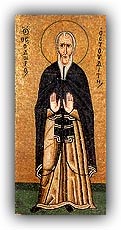 family, at Sakkoudion in Bithynia.
family, at Sakkoudion in Bithynia. Before the end of the century, Theodore went to Constantinople, where he settled in the monastery of Stoudios. There he organized a powerful monastic community according to the standards of Basil the Great's coenobitic system. Its basic principles were the absence of personal property, the communal life, compulsory labour and submission to the hierarchical superior. In the speeches Theodore addressed to the monks of the Stoudios Monastery and his disciples there these principles can be seen working together.
Most of the stoudite monks performed manual labour; as we are informed by the Biography of the saint, however, they applied 'every kind of science' and among them there were 'chanters, song writers and poets' and 'very wise calligraphers'.
Theodore was himself a prolific and dexterous calligrapher. Thus it was not surprising that he carefully (if not severely) oversaw the organization of the (scriptorium) and of the monastery library. In this way, the monastery became an important centre of manuscript production. Most works were religious in content, but not always to the exclusion of the secular.
Theodore of Stoudios was a firm supporter of icon worship.